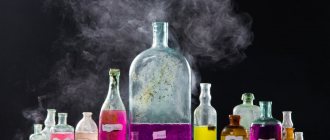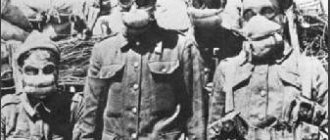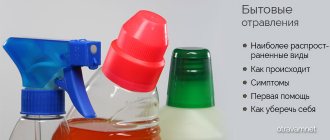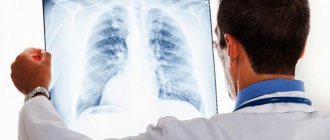Due to the growth of urbanization and the development of new chemical industries, the negative impact of toxins generated as a result of anthropogenic human activity on the environment and directly on the population has increased. According to the degree of impact on human health, toxic substances are divided into two main groups: according to the physiological effect on the body and the chemical composition of the toxins.
What is this
Toxic substances are compounds that pose a danger and are used in various areas of life. They pollute the atmosphere and negatively affect the health of living organisms. Toxic elements are the most common food contaminants.
Enter the body through food and liquid. Infection is possible through objects. Harmful compounds come in the form of gases, liquids and solids. Gaseous substances are spread by wind and can penetrate through walls and open windows.
Toxic compounds in liquid form enter the body through drinking, are present in the liquid immediately, or are formed during any chemical reactions.
The simultaneous effect of several poisons on the body enhances the adverse effect or leads to its weakening.
Toxicological classification of poisons (page 1 of 3)
1. Classification of poisons
2. Detoxification methods
3. Legislation in the field of civil defense and emergency situations
Bibliography
Conceptual apparatus
Classification of poisons
The number of chemical compounds currently used is so large, and the nature of the biological action is so diverse, that several types of classifications are used.
The existing classifications of harmful chemicals are based on various principles that take into account the state of aggregation of substances, the nature of the effect on the body, the degree of toxicity, danger and other characteristics.
Based on their state of aggregation in the air, harmful substances can be classified as gases, vapors and aerosols (liquid or solid).
Based on their chemical structure, harmful chemicals are divided into organic, inorganic and organoelement. Based on the accepted chemical nomenclature, the class and group of these substances are determined.
Along the route of penetration into the body, substances are released that act through the respiratory tract, digestive system and skin[1].
Based on the purpose of use, the following substances are distinguished.
Xenobiotics of food, these include non-nutritive (having no nutritional value) food components and anti-nutritive substances, including, in particular, various essences (esters), nitrites and nitrates, caffeine, alcohols, tannins (tannids), catechins and a number of other substances .
Industrial substances are the most diverse group.
Among the emissions into the atmosphere, soil, and water there is a group of inorganic substances containing almost all elements of the periodic system, as well as all classes of organic compounds, from the simplest aliphatic hydrocarbons to synthetic high-molecular compounds, as well as substances comparable in toxicity to chemical warfare agents .
Agrochemicals (pesticides and chemical plant protection products), which include herbicides, insecticides, fungicides, repellents, seed protectants. Without the use of these substances, today it seems unthinkable to obtain high yields of agricultural crops.
Medicines that have their own pharmacological classification.
Cosmetics, which also include some biologically active compounds that are foreign to the body and can, in certain concentrations, cause a toxic effect, such as allergic reactions.
Toxic substances (CS), which are used as toxic weapons for the mass destruction of people.
By type of toxic effect, chemical substances are divided according to the nature of their toxic effect on the body (Table 1).
Table 1
Toxicological classification of poisons
This classification is general in nature and is usually detailed using additional information about the “selective toxicity” of substances (Table 2).
table 2
Classification of harmful substances by “selective toxicity”
It should be borne in mind that the “selective” toxic effect of poison does not exhaust the entire variety of manifestations of intoxication, but only indicates the immediate danger that threatens a specific organ or system of the body as the main site of toxic damage.
According to the degree of toxicity - a hygienic classification, which is based on a quantitative assessment of the toxic hazard of chemicals, according to experimental data on determining their maximum permissible concentrations and toxicometric parameters (Table 3) [2].
Table 3
Toximetry parameters
According to the specific biological consequences of poisoning the body, the following groups of substances are distinguished:
– irritating effects, which have the indicated effect, getting on the integument, mucous membranes and, above all, on the organ of vision, the upper respiratory tract;
– sensitizing (allergic) effects that cause the occurrence of allergic diseases - bronchial asthma, asthmatic bronchitis, conjunctivitis, dermatitis; mutagenic effects that damage the genetic hereditary function of the body;
– teratogenic effect, which leads to deviations in (the development of the embryo located in the mother’s womb;
– carcinogenic effects, which ultimately lead to the occurrence of cancer;
– reproductive effects that reduce reproductive function in men and women [3].
Detoxification Methods
Detoxification is the process of neutralizing poisons and speeding up their release from the body. Various detoxification methods help free the stomach and intestines from poison that has not yet been absorbed into the blood, as well as free the blood and body tissues from the toxic substance and its metabolites contained in them.
The body is freed from poisons by enhancing certain natural physiological processes (inducing vomiting, gastric lavage, bowel cleansing, forced diuresis, hyperventilation), artificial detoxification (hemodialysis, peritoneal dialysis, hemosorption, exchange transfusion, etc.) or by antidote therapy. The above methods of freeing the body from poisons are carried out by doctors. However, life safety specialists must know the principles of the above measures and procedures aimed at removing poisons and their metabolites from the body.
Source: https://mirznanii.com/a/297858/toksikologicheskaya-klassifikatsiya-yadov
Classification of toxic compounds
The number of toxic compounds is large, so there is a need to divide all substances into several groups according to certain symptoms. Such a classification makes it possible to timely determine the characteristics of the poison and provide assistance to affected people.
What is toxicity? Harmful substances affect life, disrupting its normal course. Occupational poisonings often occur. Such intoxications can be acute - a single action of the toxin in a large volume - and chronic, when the poison enters the body in small portions, but constantly.
All poisons are divided according to the physiological effects of chemicals on humans. Which substance is the most toxic?
Groups:
- Nervous agents. This group includes compounds that cause disruption of the nervous system. When ingested, they cause vision problems, strong flow of tears, painful sensations in the chest, and disruptions in the functioning of the heart. The respiratory system is particularly affected, and spasmodic manifestations are noted. Death is possible in case of serious poisoning in the first minutes of penetration of the toxin inside. Similar substances include sarin gas, VX, tabun, soman. These toxins are the most dangerous and are prohibited for use.
- Blisters. Substances included in this list penetrate the body through the upper layer of the epidermis, violating its integrity. The first signs of such intoxication appear gradually, after some time. A person’s body temperature rises, he feels weak and apathetic. Gradually, irritation appears on the skin, redness, blisters, itching and pain are noted. Substances that enter the blood spread throughout the body and cause poisoning. Such compounds include mustard gas and lewisite.
- Generally poisonous. Toxic compounds negatively affect the functioning of the brain, cardiac system, and other organs. In case of poisoning, there is nausea, dizziness, discomfort in the heart, and problems with the respiratory system. In case of severe intoxication, convulsive manifestations, shortness of breath, respiratory failure, and cardiac arrest are diagnosed.
- Suffocating. Such compounds primarily affect the respiratory system. At the initial stages, damage to the mucous membranes of the upper respiratory tract develops, later bronchitis and pneumonia develop. Serious overdoses lead to swelling of the lungs. The victim experiences an increase in temperature, lacks air, and blood pressure drops significantly. The cause of death is pulmonary edema and respiratory failure.
- Irritants. They enter the body through the respiratory tract. Nerve endings provoke a negative effect on the mucous membranes. The victim experiences severe pain, tears flow, sneezing, and intense coughing. The pain goes away after a short period of time. Negative consequences - eye diseases, lung diseases, severe bronchitis.
- Psychochemical. Compounds of this group have a strong effect on the mental state of a person. The poisoned person has an increased desire to sleep and performance impairment. The heart rate becomes faster, dryness of the epidermis and mucous membranes is noted. Lethargy gradually manifests itself, and the person is unable to speak clearly. The duration of action of such substances is approximately four days. Substances from this group are prohibited for use.
The effect of toxic compounds manifests itself individually for each person. For some they may be poisonous, for others they will not cause any harm. Toxic products are also divided according to the type of chemical element.
- Carcinogenic compounds cause the occurrence of malignant tumors and stimulate the spread of metastases.
- Mutagenic agents have a negative effect at the genetic level, accumulate in the body and lead to the development of genetic mutations.
- Sensitizing compounds negatively affect the immune system and increase the body's sensitivity to allergens.
- Chemical substances provoke various disruptions in the functioning of all body systems and have an adverse effect on the reproductive system.
All toxic substances adversely affect the functioning of internal systems. Often poisons lead to cell destruction, which provokes complete organ failure.
Toxicity - Chemistry
pagePoisonings
Toxic substances are dangerous elements used in production, industrial enterprises, and agriculture. When they are released, nature and the human body are polluted. Toxic compounds in emergency situations or harmful conditions at chemical plants can cause poisoning of living beings and the environment.
What are and characteristics of toxic substances
Substances containing toxins often contaminate vegetables and fruits. They are present in underground and surface waters, soil, atmosphere, and plants. With the consumption of food, they enter the human body through liquid.
Peculiarities:
- it is difficult to foresee the toxicity of various substances when creating protection - a gas mask;
- infection through liquids, objects, food cannot be ruled out;
- transfer of funds by wind, covering a large area, causing intoxication;
- the negative property of contaminated vapors is to seep through walls and windows of buildings.
The combined effect of poisons on the body allows one-time toxicity to be increased or, conversely, weakened.
Effect on the body
The negative impact of the compounds poisons and leads to organ failure. Often the phenomenon becomes persistent, and then intoxication manifests itself. Symptoms occur immediately or over time.
List of effects of toxic compounds:
- Exposure provokes disturbances, stimulation of the nervous system, convulsive states appear, and affects the hematopoietic organs. Chemical elements: HCN, H2S, hydrocarbon.
- Irritant: Cl, SO2, NH3. The influx of elements damages the mucous membranes, the pathways responsible for breathing.
- Antibiotics, dust particles, and Ni can cause allergies. They increase the response of organs to the elements, allergic reactions are possible: rashes, itching, redness in areas of the skin.
- Carcinogenic elements provoke the formation of cancerous tumors: Cr oxides, C20H12.
- A negative impact on the reproductive function is caused by defects at birth, mental pathologies, and a negative impact on the development of children and offspring. Elements: H3BO3, NH3, high doses of chemical compounds.
- The mutagenic effect of the pest is based on the influence of human germ and non-reproductive cells, significant changes occur in genes, and the continuation continues for several generations ahead. Elements: Hg, Pb compounds.
The last 3 points are characterized by the fact that the consequences of the reaction to the poison extend over a long period of time.
Fibrosis of lung tissue occurs through the entry of aerosols and dust particles into the respiratory tract.
As a result of inhaling chemical vapors, a person is susceptible to diseases:
- lung cancer;
- tracheitis;
- pneumonia;
- tuberculosis;
- acute degree of intoxication.
Combined exposure is characterized by the influence of several chemical toxins that pass through the same route.
Four types of action of chemical compounds:
- summation, when substances have the same effect on organs (hydrocarbon mixture);
- potentiation - one element increases the effect of the second element;
- antagonism - one composition reduces the influence of another;
- independence, when the compositions act differently on the insides.
The complex effect provides for different ways of penetration into the interior.
The distribution system helps in providing care to the patient in a short time.
Classification of toxic substances
Hazard classes are determined in relation to established standards.
| Classification of toxic substances | Name (including anthropogenic substances) | Effect on the body |
| 1. Particularly dangerous | Phosphorus oxychloride, ethyleneimine, Hg, Be, Pu, Po. | Irritation of the mucous membranes, pain in the eyeballs, cough, suffocation, burns. |
| 2. Highly dangerous | Hydrocyanic acid, arsenous hydrogen, F, Cl, hydrogen fluoride. | They affect the blood and provoke the development of cancerous tumors. |
| 3. Moderately dangerous | Trimethylamine, phosphates, Ni, Mn. | They have a suffocating effect, irritate the mucous membranes of the respiratory tract and eye membranes. |
| 4. Low hazard | C3H6O, NH3, methyl acrylate, hydrochloric acid compounds. | They have a suffocating effect, a neurotropic effect, cause toxic pulmonary edema, and affect the somatic nervous system. |
Elements of classes 1 and 2 pose a danger to human life at low doses.
| Types of toxic substances | Name | Symptoms of poisoning |
| Nerve agents (highly toxic) | tabun, soman, sarin |
|
| Causing skin abscess | lewisite, mustard gas | Penetrate through the skin. Latent period 4 hours before symptoms appear:
|
| Generally poisonous | CO, KCN, HCN | Provoke disturbances in the brain, vascular network, heart:
In case of severe poisoning:
|
| Provoking suffocation | phosgene, diphosgene | Affects the respiratory system:
Symptoms:
Death occurs as a result of burns, gangrene, or pulmonary edema. |
| Irritant chemicals | adamsite, chloroacetophenone |
Symptoms:
Consequences:
|
| Psychochemical | BZ, nitrogen mustards | Signs observed after 3 hours:
|
A variety of potent substances entering the body can become a poison or a medicine. The degree of damage depends on the dose of the toxic element ingested.
The most dangerous route of entry into the body
The routes of entry of toxins are divided into:
- inhalation route;
- through food, liquid;
- through the skin, mucous membranes.
Ingestion of poison by inhalation provokes the entry of a toxicological element through the bronchi into the lungs, then spreads throughout the body with the blood. The nervous system is affected. Through aerosol formulations, the body's reaction occurs 20 times faster than with oral exposure.
In second place in danger are substances that penetrate through food and liquid. In the stomach, toxins are absorbed slowly. Symptoms of intoxication appear after 2-3 hours. If the poison enters through food, the process slows down. Conclusion: food intoxication is less dangerous than inhalation of chemicals.
When a toxin enters through the skin, it must undergo protection. Elements penetrate through the skin, quickly destroying the layers of the skin. Factors such as sweating and sunburn reduce the level of protection. The toxin penetrates immediately into the bloodstream. A wound is an ideal way for poison to enter the body.
Intoxication of the body depends on the dose of the toxic compound and the route of passage.
Ways to release toxic substances entering the body
Ways of excretion of substances from the body through:
- Gastrointestinal tract;
- respiratory system;
- kidneys;
- skin.
When vapors are exhaled, the odor of C3H6O, C7H8, C6H6 or chloroform is released.
Chloroform CCl4, C2H6O2, being transformed, leaves with the help of the lungs, being converted into carbon dioxide.
Toxic elements in the bloodstream are removed by removal in the renal glomeruli.
Excretion of Hg and CS2 is carried out by the glands of sweat and saliva. Most poisons are excreted from the body into the intestines with the help of bile (Pb, Hg, Mn).
When metals pass from the intestines through the bloodstream, and from it to the liver, the hepatic-intestinal path of the elements occurs, which determines the part of the metal element. The toxin is eliminated through the intestines.
Toxins negatively affect health at elevated levels. Poisons penetrate through the respiratory tract, skin, mucous membranes, food and water. The elements are toxic to the body and cause pathologies of the respiratory system and nervous system. In severe cases of intoxication, death is possible.
The article has been approved by the editors Link to main publication
articles:
(25,00
Hazard classes may cause toxins
Toxic compounds have different effects on the body. According to regulatory documents, substances are assigned a certain hazard class depending on its characteristics and degree of damage.
- The first class includes extremely dangerous toxic elements. The group includes plutonium, polonium, and beryllium. All elements are dangerous, have carcinogenic effects, and lead to the development of oncology and radiation sickness.
- The second class represents highly toxic substances. These include: arsenic, hydrogen fluoride, lead, chlorine. If they enter the body, they cause serious disruptions in the functioning of organs, cause pain, and negatively affect the nervous system and brain. Often cause death.
- The third class includes moderately dangerous toxic substances. These are phosphates, nickel, manganese. Toxins have a negative effect on the nervous system, disrupt metabolism, provoke allergic reactions and mental disorders.
- The fourth class represents low-toxic compounds. This group includes chlorides and sulfates.
Thus, all toxins have their own hazard class. This allows you to accurately determine the possible consequences of poisoning.
Classification by chemical composition
There is a classification of toxic substances according to the composition of their chemical elements. When poisoned, they affect people's health in different ways and lead to various acute and chronic diseases.
- Toxins containing carcinogenic substances. This is perhaps the largest group of poisoners. These include pesticides, nitrates, heavy metals, glutamates, aflatoxins, benzene and its derivatives and others. Their impact on the body is manifested in the formation and development of various types of malignant and benign tumors. These substances are very difficult to remove from the body.
- Mutagenic substances. The most common of this subgroup are mercury, nitrous acid, arsenic, formaldehyde, lead, and radioactive substances that are sources of various types of radiation. Under their influence, genetic changes occur in the human body, which can manifest themselves in several subsequent generations. Cause irreversible mutations.
- Sensitizing toxins. These include various antibiotics and other drugs obtained by chemical means, which themselves are non-toxic, but if used in the wrong dosage, cause harm to the body. This also includes various types of allergens (dust, pollen, etc.) and a number of chemicals that cause skin diseases (eczema, dermatitis), allergies, and asthma.
- Substances of chemical origin (acids, alkalis). They primarily affect the reproductive function of the body.
Effect on the body
How do toxic substances affect the body? Toxic compounds have different effects on humans.
- Disruption of the nervous system, the occurrence of seizures and nervous excitement.
- Negative effect on the hematopoietic organs.
- Irritation of mucous membranes and respiratory tract.
- Cause allergic reactions and increase the sensitivity of the skin.
- Provoke the development of cancer.
- They have a harmful effect on the reproductive system, causing miscarriages and infertility.
- Cause mutation at the gene level.
Lists of toxic substances
The list of 2 “toxic” substances includes more than 60 items. Among them are methyl alcohol, purified bee venom, some mercury compounds, hydrocyanic acid, strychnine, phenol, potassium cyanide, and snake venom. Toxic substances should be distinguished from potent substances (List 1), narcotic drugs and psychotropic substances (List 3). Illegal trafficking of toxic substances c. for sales purposes is prohibited by Art. 234 of the Criminal Code of the Russian Federation. In particular, illegal production, processing, acquisition, storage, transportation or forwarding for the purpose of sale, as well as illegal sale of substances that are not narcotic drugs or psychotropic substances, or equipment for their production or processing (Part 1 of Article 234 of the Criminal Code RF). For the concept of “illegal trafficking,” see “Illicit Trafficking in Drugs.”
What are household toxins?
In everyday life, people often use various toxic substances. Care and caution are required when working with them.
- Antifreeze. They disrupt the functioning of the nervous system, provoke vomiting, lethargy, and the development of convulsive phenomena.
- Poisons for rodents. There is nausea, lethargy, apathy, rarely diarrhea, bleeding from the gums.
- Psychoactive drugs. The functioning of the cardiac system is disrupted, dry mucous membranes and seizures are noted.
- Solvents. They cause pain in the abdomen, vomiting, intestinal upset, and disruption of the kidneys and liver.
- Cleaners. The person has vomiting, coughing, heart failure, and skin irritation.
- Rubbing products. An overdose is manifested by nausea, vomiting, respiratory distress, and blood in the urine.
- Medicines. Pain in the stomach and intestines, nausea, dizziness, breathing problems, vision.
Irritation, a feeling of sand in the eyes, redness are only minor inconveniences with impaired vision. Scientists have proven that decreased vision in 92% of cases ends in blindness.
Crystal Eyes is the best remedy for restoring vision at any age.
Even medicines become poison if taken incorrectly. It is not uncommon for people to suffer from paint removers, fungicides, and other toxins. In everyday life, such substances must be stored in inaccessible places.
How do toxic substances enter the body?
They can penetrate inside in different ways, which depend on the state of aggregation of the substance.
Paths and effects:
- Most often, entry occurs through the respiratory tract. In such situations, the poison quickly penetrates the circulatory system and spreads throughout the body. First of all, the nervous system suffers. Toxic vapors and gases act on all organs much faster than substances in a different state.
- In second place are poisonings resulting from ingestion of the toxin or its entry into the stomach. Harmful compounds can be liquid or solid. Such intoxications are less dangerous because there is time to provide first aid to the person. Toxins are absorbed slowly, and symptoms develop after some time.
- Penetration through the skin occurs only if the toxin has a destructive effect on the epidermis. The poison is absorbed internally and spreads throughout the body.
- The mucous membranes cannot retain harmful compounds, so penetration occurs rapidly and poisoning occurs.
- Open wounds allow toxins to pass through easily, and harmful products are quickly absorbed into the blood. Burns and frostbite slow down this process.
Any toxin poses a danger to humans, regardless of the possibility of its entry into the body. It is recommended to be more careful about toxic products.
Toxic effect. R. is characterized by high toxicity for any form of life, a wide spectrum and a wide variety of clinical manifestations of toxic effects, depending on the properties of the substances in the form of which the metal enters the body (R. vapors, inorganic and organic compounds), route of entry and dose. The mechanism of action of R. is based on the blockade of biologically active groups of a protein molecule (sulfhydryl, amine, carboxyl, etc.) and low-molecular compounds with the formation of reversible complexes with nucleophilic ligands. The inclusion of P.(II) in the transfer RNA molecule, which plays a central role in protein biosynthesis, has been established. In the initial stages of exposure to low concentrations of R., there is a significant release of adrenal hormones and activation of their synthesis. Phase changes in the content of catecholamines in the adrenal glands were noted. An increase in monoamine oxidase activity of the mitochondrial fraction of the liver is observed. The stimulating effect of inorganic compounds of R. on the development of atherosclerotic phenomena has been shown, but this connection is not clearly expressed. R. vapors exhibit neurotoxicity, the higher parts of the nervous system are especially affected. Initially, the excitability of the cerebral cortex increases, then inertia of cortical processes occurs. Subsequently, extreme braking develops. Inorganic compounds of R. are neurotoxic. There is information about the gonadotoxic, embryotoxic and teratogenic effects of R. compounds.Acute poisoning. Acute poisoning of people is usually associated with accidents (accidents, fires in mercury mines) or with gross violations of safety regulations. The clinical picture of poisoning develops after 8–24 hours and is expressed by general weakness, headache, pain when swallowing, fever, catarrhal symptoms of the respiratory tract (rhinitis, pharyngitis, less often bronchitis). Then hemorrhagic syndrome develops, accompanied by sore gums, pronounced inflammatory changes in the oral cavity (mercury stomatitis with an ulcerative process on the gum mucosa), abdominal pain, gastric disorders, signs of kidney damage, and, less commonly, pneumonia. This type of poisoning has been described among electric welders who worked with laboratory equipment contaminated with R., and in a laboratory where metal R. was mistakenly left in a metal container on an electric stove. A group poisoning of workers involved in fire cutting of a tubular-honeycomb heat exchanger supplied from acetaldehyde production has been described. The first signs of poisoning were noted within 25–30 minutes after the start of work. Against the background of general malaise, headache, trembling hands, phenomena from the gastrointestinal tract prevailed: nausea, repeated vomiting, loose stools mixed with blood, colicky pain in the epigastrium. There are known cases of acute poisoning by R. vapors with hearing damage, concentric narrowing of the visual field, ataxia and peripheral neuropathy in the absence of tremor and kidney damage.
Acute poisoning with R. compounds has been described due to erroneous ingestion of highly soluble and colorless salts - chloride
(HgCl2),
nitrate R.(II)
(Hg(NO3)2), - and their use for suicidal purposes.
Poisoning with R salts
.
manifested by headache, salivation, redness, swelling and bleeding of the gums, and the appearance of a dark border of P sulfide
. (HgS), stomatitis, swelling of the lymphatic and salivary glands, dyspeptic symptoms, colitis, tenesmus. The temperature often rises. In relatively mild cases, the impaired functions are restored after 2–3 weeks; in severe cases, sudden changes in the kidneys develop (necrotizing nephrosis). In the latter case, death occurs after 5–6 days. Digestive disorders vary in nature - from loss of appetite and nausea to vomiting (sometimes with blood) and mucous diarrhea, often bloody. Multiple ulcerations of the mucous membrane of the stomach and duodenum may occur, in some cases - atrophic changes in the liver, increased urination in the initial stage of intoxication, its decrease and even complete cessation in subsequent stages of poisoning. “Sulem” nephrosis (“sublimate kidney”) is characterized by the absence of edema; At the same time, the total protein content in the blood is increased. Lime is retained in the body due to damage to the large intestine by sublimate. During the autopsy of the dead poisoned by R. salts, there is a sharp congestion of the internal organs, numerous hemorrhages in the pleura, pericardium, peritoneum, soft meninges, sometimes in the brain tissue, mainly in the cerebral cortex and in the gray matter of the spinal cord in the form of purpurae cerefari. Cerebral edema is detected. Microscopic examination reveals acute swelling of nerve cells in various parts of the nervous system. Severe changes in mercuric chloride poisoning are found in the gastrointestinal tract, but the kidneys are especially severely affected.
Chronic poisoning. The severity and speed of development of the clinical picture of the disease is determined by the intensity of mercury exposure and the individual characteristics of the body. Mildly expressed chronic intoxication was observed at concentrations of 0.2–1.3 mg/m3 (experience about six months) and 0.035 mg/m3 (experience 3 years). Other symptoms of poisoning were diagnosed in two of the 15 people who worked in an atmosphere containing R. vapor at a level of 0.01–0.06 mg/m3. During a psychophysiological examination of 20 workers who were occupationally exposed to R. vapors, they were found to have deterioration in motor coordination, early development of fatigue, and impairment of short-term memory. In general, chronic intoxications occur for a long time without obvious signs of disease (compensated phase).
Mercurialism. The first signs: increased fatigue, weakness, drowsiness, apathy, emotional instability, headaches, dizziness (“mercurial neurasthenia”). At the same time, trembling (“mercury tremor”) develops, first of the hands, tongue, eyelids, and in severe cases of the legs and, finally, of the whole body. A state of increased mental excitability (mercurial erethism) occurs, manifested by shyness, timidity, timidity, and general depression. As the process progresses, patients become extremely irritable, gloomy, and often cry. Memory is often weakened. Hypersalivation, impaired secretory function of the stomach, cyanosis, sweating, slowing or increased heart rate, and increased urination observed with mercurialism are associated with R.’s effect on the autonomic nervous system; in the initial stage, signs of increased excitability of the sympathetic department predominate and are combined with hyperfunction of the thyroid gland. One of the important signs is a weakening of the extensor strength in the predominantly working arm. This symptom may appear in the first months of work, sometimes regardless of other signs of poisoning. Changes in the digestive organs are weak or absent, as are changes in the kidneys. The temperature is sometimes elevated. There is evidence of an increased incidence of tuberculosis and high mortality from it in contact with R. With mercurialism, disorders of the generative function and menstrual cycle are often observed: painful and heavy periods, dysmenorrhea, etc. With increasing experience with R., the number of women with disorders increases menstrual function, as well as the number of spontaneous miscarriages and premature births and the percentage of mastopathy. Chronic effects of R. on the maternal body are accompanied by water retention and the development of hidden edema in newborns, the birth of children with developmental defects and insufficiency of protective adaptive mechanisms.
Micromercurialism. A set of symptoms that occur during prolonged exposure of a person to low concentrations of R. - on the order of hundredths of mg/m3 and below. The first degree of micromercurialism is expressed mainly by decreased performance, rapid fatigue, and increased excitability. Sometimes there is a mild swelling of the nasal mucosa. Micromercurialism of the second degree is characterized by greater severity of the same phenomena, increasing weakening of memory, anxiety and self-doubt, irritability and headaches. Diagnosis of micromercurialism is often difficult. Many cases of it occur under the guise of diseases of the respiratory tract or nervous system, depending on which phenomena predominate. Cases of micromercurialism are often hidden under the diagnosis of neurasthenia, hysteria, etc.
The phenomena of micromercurialism are often identified among employees of research institutions who worked under conditions of exposure to low concentrations of R. (at the level of maximum permissible concentrations or higher) for 8–10 years (in some cases, with an experience of 3 years). The main manifestations of micromercurialism were expressed in them in the form of a neurasthenic syndrome with symptoms of autonomic dysfunction with mental disorders expressed to varying degrees (increased irritability, emotional instability, increased fatigue, decreased mental performance with weakening of attention, memory impairment, etc.). In almost all cases, characteristic small and frequent tremor of the fingers of outstretched arms was noted; in many cases, tremor of the eyelids and tongue was detected.
Intoxication with R. compounds is possible with prolonged intake into the body through the respiratory tract. Its picture is similar to that described above, but there are also features characteristic of individual salts. When exposed to fulminate dust P
.
(Hg(CNO)2) irritation of the conjunctiva of the eyes, a burning sensation in it, in some cases conjunctivitis, runny nose, catarrh of the upper respiratory tract, irritation in the pharynx are noted. Poisoning by R. rattlesnake
. usually weaker than intoxication with R. vapors; mercury erethism is extremely rare. R. fulminate dust can cause sensitization and the development of dermatitis with skin redness, swelling, and itching; swelling is especially noticeable in the eye area, back of the head, ears and on the forearms. Papules and nodules are visible against the background of inflamed skin; pustular folliculitis develops, ulcers appear. During the recovery period, peeling occurs for 1–2 weeks. Relapses are possible.
Environmental measures. Environmental protection is achieved by purifying ventilation emissions and wastewater from waste, recycling waste, and regulating the conditions for the use of municipal and industrial wastewater and slag and their purification from waste in agriculture.
Prevention measures. One of the main and effective preventive measures when working with R. and its compounds is the development of technological processes that exclude the use of this metal. Taking into account the peculiarities of the physicochemical properties of R. and its compounds, which have the ability to intensively pollute the environment and work surfaces, which are constant sources of R. release, it is advisable to use a full range of hygienic requirements set out in regulatory documents in relation to specific production conditions. It is strictly prohibited to store and eat food, as well as smoking in rooms where vapors of R. and its compounds are released. After finishing work, you should take off your overalls, take a shower, rinse your mouth and brush your teeth. Medical examinations: preliminary (upon entry to work) and periodic.
Personal protection. In accordance with the classification of harmful substances in relation to the purpose of RPE, R. and substances containing it belong to the fourth group (vapor-gas-air mixtures). Depending on the content of aerosols in the air, filtering RPE types FG or FU of different degrees of protection are recommended. For protection against R. vapors and its organic compounds at concentrations exceeding the maximum permissible by no more than 15 times, filtering gas mask respirators RPG-67G . In conditions of exposure to aerosol of condensation and disintegration of inorganic compounds of R. - a filtering respirator ShB-1, "Lepestok" or an MP 5-5 valve respirator with an anti-mercury cartridge of grade G. Those working with R. and its compounds must remove special clothing and personal protective equipment before eating equipment, wash your hands and rinse your mouth with a 0.25% solution of potassium permanganate.
First aid. Specific methods of treatment include the administration of substances that form strong, low-toxic, water-soluble complex compounds with R. that are excreted in the urine.
Antidotes for R. also include oxathiol and D-penicillamine. The advantages of oxathiol include high efficiency and low toxicity. D-penicillamine, whose molecule contains carboxyl, amine and sulfanyl groups, forms water-soluble complexes with P. Used internally. Available in gelatin capsules of 0.15 g. Single dose 0.15–0.30 g, daily dose 0.6 g. In case of severe acute poisoning through the mouth, the stomach should be immediately rinsed copiously with water with 20–30 g of activated carbon or protein water, then give milk, egg whites beaten with water, and then a laxative. In case of acute, especially inhalation, poisoning with R. vapors, complete rest is necessary after removing the victim from the affected area.
What are harmful chemicals?
Harmful chemicals are chemicals whose contact can harm human health. The consequences of poisoning with some poisons affect the next generation.
Constant contact with polymers, dyes, solvents, fertilizers and other chemical compounds does not go unnoticed. Workers in production are faced with occupational intoxication due to violation of safety regulations and have chronic occupational diseases after many years of contact with toxic elements.
Sources of harmful substances
When grinding raw materials, toxic dust is a by-product. They enter the air from open containers, from gaps between equipment parts, or when moving to another container. Small particles can hang in the air for a long time and penetrate the respiratory system.
Harmful liquids penetrate through the joints in the pipes and splash out when overflowing. They get on the skin of workers and cause chemical burns. Liquid evaporates from equipment surfaces, floors, and walls. The air in the production area becomes saturated with harmful vapors and becomes dangerous. Evaporation also occurs from open containers.
Harmful vapors seep through the cracks between the container and the lid when the containers are opened.
Heating equipment releases a significant amount of toxic substances. When raw materials are burned, tiny particles enter the air. Equipment in hot shops and the building itself are saturated with poisons. Then brick or wooden walls release them into the external environment and pose a danger, even if production is no longer carried out in the building.
Classification of harmful substances
The number of chemicals increases every year and now reaches 7 million. Of these, 60 thousand are widely used in industry and everyday life. They differ in their state of aggregation, the nature and intensity of their impact on human health. 3 classifications apply.
By degree of toxicity (hazard classes)
GOST 12.1.007.-76 divides harmful elements and compounds into 4 groups according to the intensity of the destructive effect on the human body:
- 1 – extremely dangerous (potassium cyanide, sodium cyanide, hydrogen cyanide, phosphorus oxychloride, hydrogen fluoride, mercury, plutonium, polonium, ozone, lead oxide, benzopyrene, vinyl chloride);
- 2 – highly hazardous (sodium hydroxide, lead, nitrites, styrene, antimony, arsenic, phenol, hydrogen sulfide, chloroform, fluorine, hydrochloric and sulfuric acids, formaldehyde);
- 3 – moderately dangerous (gasoline, nitric acid, compounds of manganese, aluminum, copper, nickel, silver);
- 4 – low-hazard (kerosene, ethanol, ammonia, methane).
What are toxic substances: list and classification – Without toxins
18.02.2020
It is impossible to imagine modern life and production without chemicals. When in close contact with them, the human body has some effect.
It should be noted that there are also compounds that will manifest their influence after a certain period of time.
In this article we will try to understand what chemical factors exist, the hazard classes of harmful substances, and also how they affect the human body.
Human use of chemicals
Several million chemical compounds are now known, and most of them are used by humans in various industries. If we consider the hazard classes of chemicals from the point of view of application, the list may look like this:
- Toxic substances used in industry. These include: dyes (aniline), among solvents this is dichloroethane, for example.
- Pesticides are widely used in the agricultural industry.
- Chemical compounds that are used in everyday life: hygiene products, for sanitary treatment.
- Toxic substances of natural origin, such as plant and animal poisons.
- Poisonous substances: mustard gas, phosgene and others.
Various classes of hazardous chemicals can enter the body through the respiratory system, skin or mucous membranes. Substances can exert their negative effects selectively, that is, on a specific organ system. For example, lead affects the human reproductive system, and nitrogen oxides can cause swelling of the lung tissue.
Toxic effects of chemicals
If we consider the hazard class of chemicals, GOST distinguishes several groups. Each also has its own divisions.
There are five classes depending on the toxic effects and the average lethal dose.
- The first hazard class includes compounds that require very little to damage the body. For example, when ingested, this amount is 50 mg per kilogram of human weight.
- Class 2 includes substances whose concentrations may be higher to cause toxic effects. This can be from 5 to 50 mg per m3 if exposure occurs through the skin or gastrointestinal tract.
- Classes 3 and 4 include compounds that require more than the first two classes and usually amount to up to 5000 units.
- The fifth class includes substances that cause deep toxic damage.
Chemicals and the organ of vision
If we take into account the effect of chemicals on the organ of vision, the following classes are distinguished:
- The first class includes compounds that lead to irreversible changes in the ocular apparatus, and all this ends in visual impairment.
- The second class contains substances that cause pathological changes in vision, but they can subside within a few weeks.
Exposure to chemicals on the skin
There is another classification, it identifies classes of chemicals that have a negative effect on the skin. When dividing compounds, two criteria were used. Considering the first, three classes are distinguished:
- The first group includes substances that lead to visible skin necrosis.
- The second class includes substances that cause reversible damage. In about two weeks, the skin is restored.
- Substances in class three cause only minor skin irritation, which usually goes away within a couple of days.
The second classification criterion is used in cases where there is insufficient data to classify substances into the first three groups.
Impact of chemical compounds on the environment
According to GOST, there is also a classification that takes into account the impact of chemical compounds on the environment. This group includes the following categories of substances:
- Detrimental to the ozone layer.
- Having an acute toxic effect on the aquatic environment.
- Substances that have a gradual toxic effect on the inhabitants of water resources.
All these harmful compounds can be further divided into categories based on their harmfulness. A concentration of 0.1 mg/l is sufficient to produce a toxic effect.
Classification of chemicals by hazard classes
In the huge variety of known substances, not all are equally dangerous to the human body. The following classes are distinguished:
- The first class includes extremely dangerous substances and compounds. To cause death, 15 mg of the substance per kilogram of a person’s weight will be sufficient to enter the stomach. Examples include the following: potassium cyanide, mercury, nicotine and others.
- The second class includes highly hazardous substances. The lethal dosage ranges from 15 to 150 mg per kilogram of body weight, taking into account the properties of the substance. These compounds have a negative impact not only on humans, but also on the environment. These include: arsenic, lithium, lead, chloroform.
- Moderately hazardous is the third class of hazard of chemicals. For death, 500-2500 mg/kg is sufficient. When ingested, the lethal dose is 150-5000 mg/kg body weight. This class includes: gasoline, aluminum and manganese compounds. Since many substances in this class are used frequently in everyday life, they should not be handled carelessly.
- Low-hazard substances are the most harmless, as they are distinguished by their low toxicity and danger. These substances often surround us, for example, ammonia can be found in every first aid kit, kerosene is used in lamps, ethanol is used in medicine and is found in alcoholic beverages.
No matter how many hazard classes of chemicals there are, it is important to treat them all with extreme caution and follow all safety precautions when working with them.
Classification of substances according to their effects on the body
All available chemicals and compounds differ from each other not only in the degree of toxicity, but also in the nature of the effect on humans.
Depending on their hazard class, all substances are assigned a specific color.
- Extremely hazardous substances are indicated in red.
- A high degree of danger is indicated in orange.
- Moderately dangerous are yellow in color.
- Substances that are classified as low-hazard are indicated in green.
Classification of substances in terms of toxic effects
The toxicity of chemicals is completely different, and the hazard classes in this regard are as follows:
- Substances that have a nerve paralytic effect include: insecticides, nicotine, sarin.
- Compounds that cause inflammatory processes and necrotic changes in combination with general toxic effects. Examples include: vinegar essence, arsenic, mercury.
- Compounds that cause convulsions, coma, cerebral edema, that is, they have a general toxic effect. These include: hydrocyanic acid, carbon monoxide, alcohol.
- Asphyxiants (fosten, nitrogen oxides).
- Substances that cause tearing and irritation of mucous membranes. An example is: vapors of acids and alkalis.
- Substances and compounds that affect the psyche. This includes narcotic substances, atropine and others.
If you are going to use or come into contact with these substances, take special care.
International classification
We looked at how many hazard classes of chemicals exist according to GOST, but there is also a division based on international requirements. It represents 9 groups, each of which has its own rules for transportation and storage.
- Substances that can easily explode or catch fire.
- The second class includes substances that are flammable, toxic, and chemically unstable.
- Chemicals in liquid state that are highly flammable are classified as Class 3.
- Class 4 includes solid substances capable of spontaneous combustion or combustion after external influence.
- Organic oxidizers belong to class 5, as they are capable of releasing oxygen, which supports combustion.
- Class 6 – these are toxic substances that cause severe poisoning or death if vapors are inhaled.
- The next class is radioactive substances.
- Corrosive substances are the eighth hazard class.
- Class 9 included all other substances that were not included in the previous classes, but to some extent may be dangerous.
How to protect yourself from hazardous substances
It is important not only to know the hazard class of chemicals, but also to be able to minimize the degree of impact on the human body and nature. To do this, you can use the following methods:
- Place toxic and harmful substances in enterprises as far as possible from workplaces.
- Have a modern and efficient ventilation system to remove hazardous substances.
- Use personal protective equipment in a timely manner.
- Use modern methods of water purification before releasing it into the environment.
- Dilute harmful compounds to acceptable concentrations.
The use of these available methods will maximize the safety of humans and nature from the effects of harmful chemicals.
Let's sum it up
If we summarize all that has been said, we can not only identify the hazard class of chemicals, but also note the following types of exposure to harmful compounds:
- Irritating effect, if they come into contact with the skin, they cause redness, for example, fluorine, phosphorus, etc.
- The cauterizing effect of the substance can cause burns of varying degrees. These include: ammonia, hydrochloric acid.
- Asphyxiants can cause asphyxia and death. Phosgene and chloropicrin have this effect.
- Substances with toxic effects can cause poisoning of varying severity. These include: hydrogen sulfide, hydrocyanic acid, ethylene oxide and others.
- Mutagenic substances can cause mutations.
- Carcinogenic exposure leads to the development of cancer.
Some classifications also identify narcotic substances, which, once inside the body, cause addiction and gradual poisoning of the body.
https://www.youtube.com/watch?v=U-YlOW8ri9Y
So we got acquainted with the variety of chemical substances that surround us almost everywhere. Without chemistry it is almost impossible to imagine modern industry and production. But in order not to cause harm to your body during interaction with harmful substances, you must take special care and know the rules of storage and transportation.
- 25.03.2016
- 0
- Business articles
Source:
Chemical hazard class. List, table of hazard classes of chemicals:
In the process of life, people are faced with a huge number of chemicals that have an effect not only directly upon unprotected contact, but also after a certain period of time.
To date, about seven million compounds are known, of which more than sixty thousand are used by humans. Every year, more than a thousand new chemical substances or their mixtures appear in the world, which have different effects on organisms.
Maximum permissible concentrations of harmful chemicals
The maximum permissible concentration is the highest percentage of a toxic element in the environment (air or water) that does not harm living beings. In production, a maximum permissible concentration is determined that will be safe with regular contact for several years.
Each compound has its own maximum permissible concentration. Air parameters are determined in μg/m3.
MAC norms are determined by SES.
REFERENCE! 65% of Russians live in regions where the MPC for some substance is exceeded.










